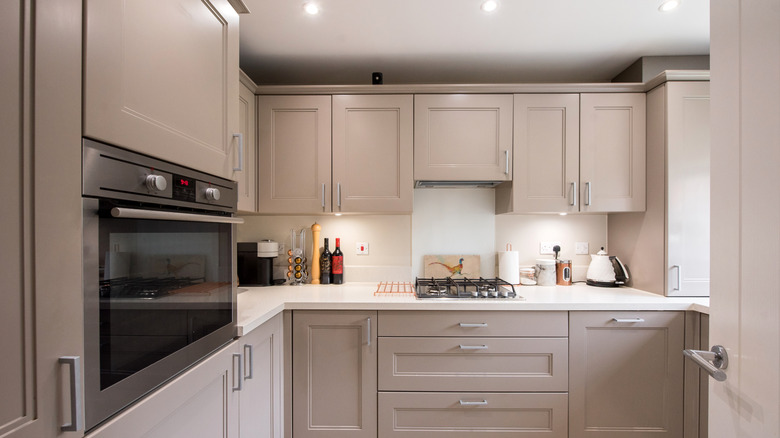Are Inset Or Overlay Cabinets Better For Your Home? Here's What To Consider
We may receive a commission on purchases made from links.
If you're planning a kitchen renovation or redesign, you've probably heard the words "overlay" and "inset" mentioned when it comes to cabinets. However, if you're unfamiliar with these terms, it might seem difficult to identify the key differences between the two. More challenging still is deciding which of these cabinetry styles works best with your home's existing or planned interior design. In an inset cabinet design, the doors sit fully within the cabinet box. As a result, the doors are completely flush with the face frame, which remains fully visible. This arrangement makes the entire installation look seamless. A notable exception to this is a beaded inset style, which adds a small groove around the doors. Overlay cabinets, by comparison, are so named because their doors and drawers sit over the frame and either partially or fully cover it.
You might already have an idea of what you'd like your space to look like, but describing this image for your cabinet manufacturer might require some specific terminology. Though you'll often hear the words inset and overlay used in reference to kitchen cabinets, the same terms can apply when selecting new bathroom cabinets. In either space, the right cabinets will help you add storage and visually declutter your countertops. Knowing the differences between inset and overlay cabinets and the benefits and drawbacks of each one will help you feel confident when it comes to making a decision about your cabinets.
Inset cabinets look luxurious but require special planning
The smooth edges and seamless transitions of inset cabinets can give your kitchen a classic, luxurious appeal. In this arrangement, the hinges are completely hidden within the doors, allowing other hardware components, such as your knobs and drawer pulls, to take center stage. Because they don't require a space filler, inset cabinets can be set into a corner with ease, and rarely require you to worry about hinge clearance when opening them. As a result, the door and drawer corners are less susceptible to damage than those in overlay cabinets. If you run into a situation where the doors are binding with the frame, it's typically easy to adjust the height and depth of the installation via the hinges, especially if you have a product like Blum compact soft close overlay hinges.
Though inset cabinets can look neat and compact, there are some design limitations to watch out for when you're planning your kitchen renovation to maximize your investment. First, it's not advisable to use slab doors with this arrangement, since they don't leave enough space for the wood to naturally expand and contract from normal humidity and temperature changes. Second, any imperfections in the cabinet frame will likely be visible, since your doors won't be covering the frame. Inset doors also work best with a product like FastCap euro cabinet door stops, which reduce strain on the hinges and prevent the doors from swinging inward. Last but not least, it's important to know that inset cabinets can cost significantly more than their overlay counterparts because there is less room for errors or imperfections.
Overlay cabinets are traditional but have visual drawbacks
There are two common forms of overlay cabinets. The first is called a partial overlay and is so named because the cabinet doors and drawers only cover a portion of the frame. The distance between the doors and drawers in this arrangement is usually about half an inch. Partial overlay cabinets have a more traditional aesthetic. Some homeowners will like them, but others might consider them to be dated. However, partial overlays are easy to design and assemble. They also use less building materials than alternative overlays, which helps keep the cost low.
A full overlay cabinet closes the gap between the doors and drawers as much as possible, so that the frame is barely visible. This arrangement creates a clean, modern design. Beyond any visual preferences, the main factor to remember when considering full overlay is the door clearance. While it might seem smart to eliminate the gaps on the surface of the cabinet front, this makes it more likely that you'll end up with a bind between the edges of two neighboring doors when you go to open one of them. Using filler strips or extending the face frame can fix this issue, but will likely come at an extra cost. Before you choose between inset and overlay cabinets, don't forget to review your interiors and choose the perfect design style for your space. And of course, make sure to shop around and gather quotes from cabinet manufacturers before making any firm decisions.

